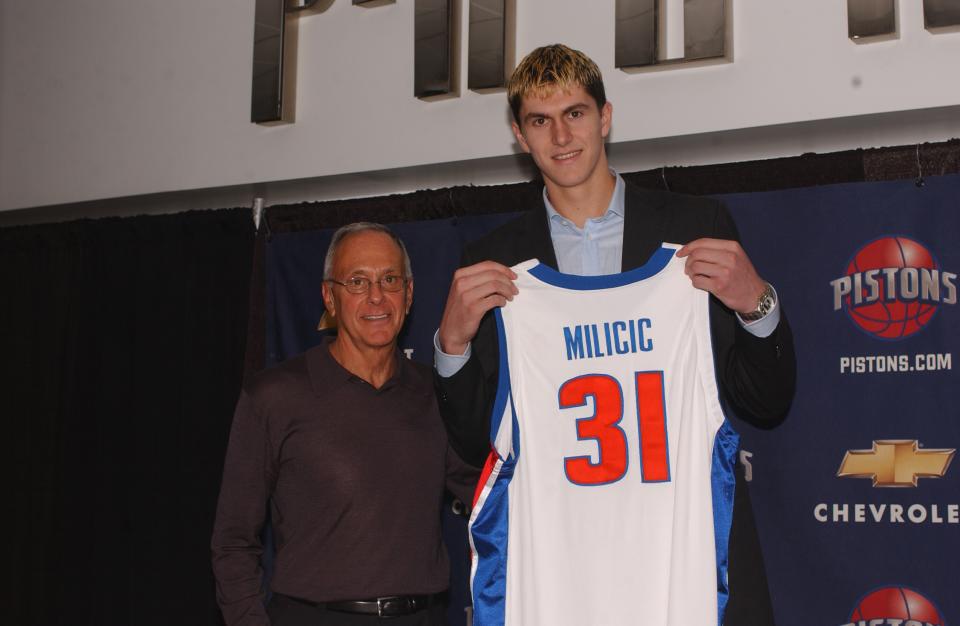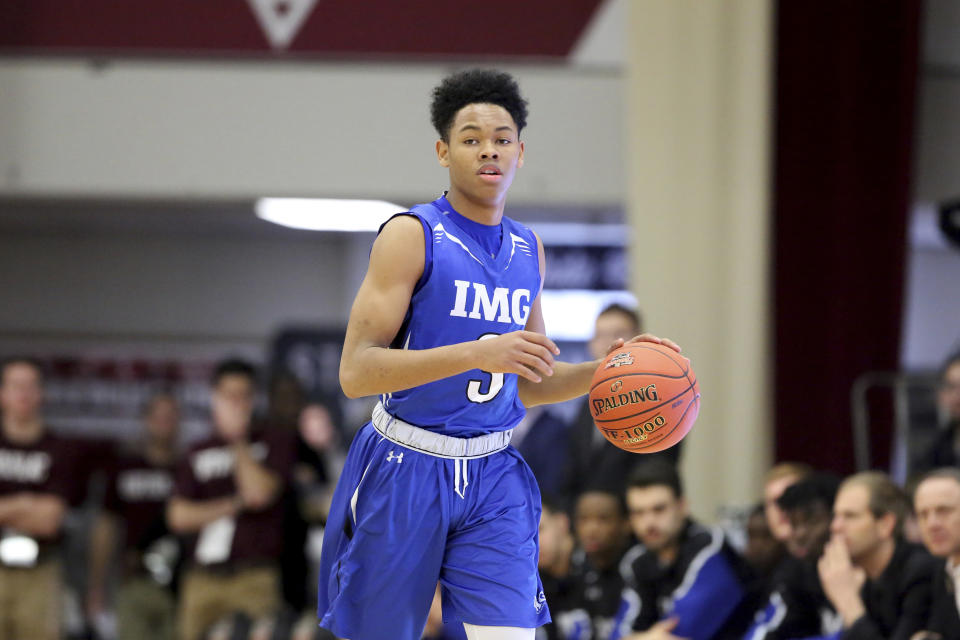'The Darko Effect': How an all-time NBA draft bust is still impacting the game
CHICAGO – The collective groan could be heard through the clusters of scouts and NBA executive glitterati gathered here for the draft combine. The “Darko Effect” reared its head Thursday when two more untested prospects decided not to participate in the five-on-five matchups for top prospects.
Itinerant forward Billy Preston and slender guard Anfernee Simons, neither of whom played in a regular-season college basketball game, both opted for the aura of mystery over the risk of more exposure by sitting out the competitive sessions here. They joined another prospect who bailed on college basketball, 7-foot center Mitchell Robinson, who announced earlier in the week that he’d be skipping all NBA combine activities, including physical testing and team interviews. (Former prep star Michael Porter Jr., who battled back injuries at Missouri and projects as a top-10 pick after just three college games, followed their lead and didn’t participate in five-on-five workouts at the combine.)
“It’s the Darko effect,” grumbled a veteran NBA executive Thursday night. “When he got drafted, it changed everything. Now no one wants to participate and risk getting shown up.”
The executive references Darko Milicic, the pantheon draft bust who the Detroit Pistons selected No. 2 overall in 2003, ahead of three Hall of Fame talents – Carmelo Anthony, Chris Bosh and Dwyane Wade. One would assume that any association to Milicic would be avoided, as he’ll forever be a central character in the bar debate of disastrous draft picks.
But part of Milicic’s oddball legacy – other than FreeDarko.com – is that he’s become the patron saint of draft workout dodgers. Milicic’s legend in agent circles is that he made nearly $47 million in NBA salary despite modest production and questionable mental make-up. As the years passed, the allure of the elusive became as commonplace as Milicic’s name atop all-time draft bust lists. (Playing in Serbia for two seasons ahead of the 2003 draft, Milicic hadn’t really faced any NBA-level opposition, so there should have been plenty of questions about his game and mental acuity. It also didn’t help that many American news outlets were effusive in their praise, putting him on a pedestal he couldn’t possibly reach. At any rate, then-Pistons GM Joe Dumars was so enamored with Milicic that he didn’t bother properly vetting him.)

Everyone from Australian guard Dante Exum to big-man Thon Maker to super-flop Mouhamed Sene opted for the comfort of the unknown over the risk of exposure. And it worked for all of them. Exum went No. 5 out of Australia and Maker went No. 10 after time at a Canadian prep school. Sene used one dazzling Hoops Summit performance to hoodwink the Seattle brass into making him perhaps the most irrelevant top-10 pick of this generation. Their careers have taken different trajectories, but they all ended up as Darko disciples of competitive predraft apathy. (And so have many others to varying degrees, including Enes Kanter, Terrance Ferguson and the immortal Bruno Caboclo, who is still two years away from being two years away.)
There are also counter-examples of why exposure can be harmful to a prospect’s immediate bottom line. Consider Andre Drummond, who initially thought about going to the NBA out of prep school. Instead, he announced in August 2011 that he’d attend UConn, and his milquetoast season there dropped him from the presumptive No. 1 pick to the No. 9 overall selection. Drummond still ended up a max-contract player, but his decision to attend college hurt his early career earnings.
“This stuff everyone worries about can affect draft stock,” said an NBA scout, “but it usually doesn’t affect long-term outcome.”
What will become of this year’s draft Mystery Men?
The decision of Robinson was one of the buzzes of Chicago this week. Robinson is a 7-foot-1, 225-pound big man whose only collegiate exposure came from a murky few weeks at Western Kentucky. Robinson enrolled last summer in the Conference USA program – a puzzling decision for a first-round talent – and then left the school. He returned and then bailed again in September and worked out in preparation for the draft. (He’s represented by agent Raymond Brothers, who helped orchestrate the circuitous careers of Emmanuel Mudiay and Ferguson.)
Robinson is talented, athletic and mysterious enough that he’d been perceived as a late first-round pick. Did he receive a promise? Or did Brothers think Robinson would flop in team interviews and just keep him out of town?
“He played low-level high school basketball and hasn’t been playing that long, so it’s unclear how good he’ll be,” said another NBA scout. “But the mystery guys always seem to benefit.”
A handful of NBA scouts polled here reluctantly agreed with Simons’ decision to not play. Simons is a 6-foot-3 shooting guard who weighs just 178 pounds. (One did call the decision not to play “annoying as hell.”)

Simons had initially committed to attend Louisville, but de-committed after Hall of Fame coach Rick Pitino got fired in the wake of the federal investigation. He attended IMG for a prep season this year and entered the draft because he’s one year removed from high school graduation and will turn 19 in June.
After “talking to my parents about it and praying about it, we talked about it a lot over the last two months,” Simons said. “I’m going to make this jump and go all in when I do it.”
All in except for actually playing. Simons is so slight that he’d have been pushed around during the five-on-five games here, so he sat out to preserve his buzz and stock. (Brian Bowen, the former Louisville recruit who sat out this season in the wake of the scandal, appeared physically overmatched on Thursday.)
“It would have been a huge step up from the competition Simons was facing at IMG,” said an NBA scout, “and he’d be completely physically overmatched against some of the other guards here.”
The biggest grumbles were reserved for Preston, a 6-foot-10 forward who attended four different high schools and left Kansas amid an NCAA investigation into his use of a car. Preston played briefly and unimpressively in Bosnia, before returning home. He also ended up in a recent superseding indictment that alleged a Preston family member conspired with Adidas to receive $90,000 so he’d attend Kansas.
With all that baggage accompanying all those stops, Preston said he declined to play after consulting with his agent. He’s unlikely to have a promise of any significance, as he’s not expected to be drafted. There are questions about his desire and love of the game, and his decision to sit out the competitive portion of Chicago shrouds him with only more skepticism.
Preston claims he has grown up through his journey.
“That was when I was a boy,” he said Thursday. “I’m a man now. I think everything I’ve been through up to that point I learned from it and taken a better direction.”
That direction pointed away from the court, another example of how the Darko Effect has gone from an exception to an annual expectation.
More from Yahoo Sports:
• Star recruit may not be welcome in NBA or NCAA
• Shaq’s ridiculous mansion on the market for $28M
• Reuben Foster’s ex-girlfriend says she made up allegations
• Former UEFA president: 1998 World Cup draw was fixed
